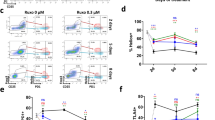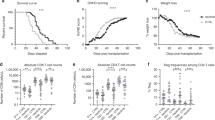Abstract
Summary:
Natural killer T (NKT) lymphocyte cells are a subset of regulatory lymphocytes with important immunemodulatory effects. Our aim was to evaluate the effect of transplantation of NKT lymphocytes on graft versus host disease (GVHD) in a murine model of semiallogeneic BMT. GVHD was generated by infusion of 2 × 107 splenocytes from C57BL/6 donor mice into irradiated (C57BL/6 × Balb/c)F1 recipient mice. Adoptive transfer of increasing numbers of DX5+ cells was performed. Recipient mice were followed for histological parameters of GVHD-associated liver, bowel, and cutaneous injury. Intrahepatic and intrasplenic lymphocytes were isolated and analyzed by FACS for CD4+ and CD8+ subpopulations. It was seen that adoptive transfer of 4.5 × 106 DX5+ cells significantly alleviated GVHD-related hepatic, bowel, and cutaneous injury, and improved survival (85% survival on day 28). In contrast, depletion of DX5+ cells led to severe GVHD-associated multiorgan injury and 100% mortality. A direct correlation with the number of transplanted DX5+ cells was noted (maximal effect with transplantation of 4.5 × 106 DX5+ cells). Tolerance induction was associated with an increased peripheral CD4/CD8 ratio, intrahepatic trapping of CD8 lymphocytes and a shift towards a Th2-type cytokine profile, manifested by decreased IL-12/IL10, IL-12/IL-4, IFNγ/IL-10, and IFNγ/IL-4 ratios. Transplantation of DX5+ cells holds promise as a novel therapeutic measure for GVHD.
This is a preview of subscription content, access via your institution
Access options
Subscribe to this journal
Receive 12 print issues and online access
$259.00 per year
only $21.58 per issue
Buy this article
- Purchase on Springer Link
- Instant access to full article PDF
Prices may be subject to local taxes which are calculated during checkout





Similar content being viewed by others
References
Ferrara JLM, Deeg HJ . Graft versus host disease. N Engl J Med 1991; 324: 667–672.
Vogelsang GB . Graft versus host disease: implications from basic immunology for prophylaxis and treatment. Cancer Treat Res 1997; 77: 87–97.
Taylor PA, Lees CJ, Blazar BT . The infusion of ex-vivo activated and expanded CD4+CD25+ immune regulatory cells inhibits graft-versus-host disease lethality. Blood 2002; 99: 3493–3499.
Cohen JL, Trenado A, Vasey D et al. CD4+CD25+ immuneregulatory T cells: new therapeutics for graft-versus-host disease. J Exp Med 2002; 196: 401–406.
Hoffmann P, Ermann J, Edinger M et al. Donor-type CD4+CD25+ regulatory T cells suppress lethal acute graft-versus-host disease after allogeneic bone marrow transplantation. J Exp Med 2002; 196: 389–399.
Edinger M, Hoffmann P, Ermann J et al. CD4+CD25+ regulatory T cells preserve graft-versus-tumor activity while inhibiting graft-versus-host disease after bone marrow transplantation. Nat Med 2003; 9: 1144–1150.
Jones SC, Murphy GF, Korngold R . Post-hematopoietic cell transplantation control of graft-versus-host disease by donor CD4+CD25+ T cells to allow an effective graft-versus-leukemia response. Biol Blood Marrow Transplant 2003; 9: 243–256.
Lan F, Zeng D, Higuchi M et al. Predominance of NK1.1+TCRαβ+ or DX5+TCRαβ+ T cells in mice conditioned with fractionated lymphoid irradiation protects against graft-versus-host disease: ‘natural suppressor’ cells. J Immunol 2001; 167: 2087–2096.
Higuchi M, Zeng D, Shizuru J et al. Immune tolerance to combined organ and bone marrow transplants after fractionated lymphoid irradiation involves regulatory NKT cells and clonal deletion. J Immunol 2002; 169: 5564–5570.
Zeng D, Lewis D, Dejbakhsh-Jones S et al. Bone marrow NK1.1- and NK1.1+ T cells reciprocally regulate acute graft-versus-host-disease. J Exp Med 1999; 189: 1073–1081.
Lan F, Zeng D, Higuchi M et al. Host conditioning with total lymphoid irradiation and antithymocyte globulin prevents graft-versus-host-disease: the role of CD1-reactive natural killer T cells. Biol Blood Marrow Transplant 2003; 9: 355–363.
Gumperz JE, Brenner MB . CD1-specific T cells in microbial immunity. Curr Opin Immunol 2001; 13: 471–478.
Mars LT, Laloux V, Goude K et al. Cutting edge: Vá14Já281 NKT cells naturally regulate experimental autoimmune encephalomyelitis in nonobese diabetic mice. J Immunol 2002; 168: 6007–6011.
Sharif S, Arreaza GA, Zucker P, Delovitch TL . Regulatory natural killer T cells protect against spontaneous and recurrent type I diabetes. Ann NY Acad Sci 2002; 958: 77–88.
Kawano T, Cui J, Koezuka Y et al. CD1d-restricted and TCR-mediated activation of Vá14 NKT cells by glycosylceramides. Science 1997; 278: 1626–1629.
Chen H, Paul WE . Cultured NK1.1+CD4+ T cells produce large amounts of IL-4 and IFNγ upon activation by anti-CD3 or CD1. J Immunol 1997; 159: 2240.
Crispe IN . Hepatic T cells and liver tolerance. Nat Rev Immunol 2003; 3: 51–62.
Smyth MJ, Crowe NY, Hayakawa Y et al. NKT cells – conductors of tumor immunity? Curr Opin Immunol 2002; 14: 165–171.
Kaneko Y, Harada M, Kawano T et al. Augmentation of Vá14 NKT cell-mediated cytotoxicity by interleukin 4 in an autocrine mechanism resulting in the development of concanavalin A-induced hepatitis. J Exp Med 2000; 191: 105–114.
Lee PT, Putnam A, Benlagha K et al. Testing the NKT cell hypothesis of human IDDM pathogenesis. J Clin Invest 2002; 110: 747–748.
Terabe M, Matsui S, Noben-Trauth N et al. NKT cell-mediated repression of tumor immunosurveillance by IL-13 and the IL-4R-STAT6 pathway. Nat Immunol 2000; 1: 515–520.
Moodycliffe AM, Nghiem D, Clydesdale G, Ullrich SE . Immune suppression and skin cancer development: regulation by NKT cells. Nat Immunol 2000; 1: 521–525.
Ilan Y, Gotsman I, Pines M et al. Induction of oral tolerance in splenocyte recipients toward pretransplant antigens ameliorates chronic graft versus host disease in a murine model. Transplantation 2000; 95: 3613–3619.
Nagler A, Ohana M, Alper R et al. Induction of oral tolerance in bone marrow transplantation recipients suppresses graft-versus-host disease in a semi-allogeneic mouse model. Bone Marrow Transplant 2003; 32: 363–369.
Johnson BD, Dagher N, Stankowski WC et al. Donor natural killer (NK1.1+) cells do not play a role in the suppression of GVHD or in the mediation of GVL reactions after DLI. Biol Blood Marrow Transplant 2001; 7: 589–595.
Taylor PA, Noelle RJ, Blazar BR . CD4+CD25+ immune regulatory cells are required for induction of tolerance to alloantigen via costimulatory blockade. J Exp Med 2001; 193: 1311–1318.
Wilson MT, Singh AK, Van Kaer L . Immunotherapy with ligands of natural killer cells. Trends Mol Med 2002; 8: 225–231.
Murphy WJ, Longo DL . The potential role of NK cells in the separation of graft-versus-tumor effects from graft-versus-host disease after allogeneic bone marrow transplantation. Immunol Rev 1997; 157: 167–176.
Kolb HJ, Schmid C, Chen X et al. Adoptive immunotherapy in chimeras with donor lymphocytes. Acta Haematol 2003; 110: 110–120.
Wayne AS, Barrett AJ . Allogenenic hematopoietic stem cell transplantation for myeloproliferative disorders and myelodysplastic syndromes. Hematol Oncol Clin North Am 2003; 17: 1243–1260.
Crispe IN, Dao T, Klugewitz K et al. The liver as a site of T-cell apoptosis: graveyard, or killing field? Immunol Rev 2000; 174: 47–62.
Belz GT, Altrnan JD, Doherty PC . Characteristics of virus-specific CD8+ T cells in the liver during the control and resolution phases of influenza pneumonia. Proc Nad Acad Sci USA 1998; 95: 13812–13817.
Baker J, Vernerts MR, Shizuru JA, Negrin RS . Expansion of cytolytic D8+ natural killer T cells with limited capacity for graft-versus-host disease induction due to IFN γ production. Blood 2001; 97: 2923–2931.
Acknowledgements
This work was supported in part by the following grants: Israel Cancer Research Fund (to AN); grants from ENZO Biochem Inc., NY and the Roaman-Epstein Liver Research Foundation (to YI).
Author information
Authors and Affiliations
Corresponding author
Rights and permissions
About this article
Cite this article
Margalit, M., Ilan, Y., Ohana, M. et al. Adoptive transfer of small numbers of DX5+ cells alleviates graft-versus-host disease in a murine model of semiallogeneic bone marrow transplantation: a potential role for NKT lymphocytes. Bone Marrow Transplant 35, 191–197 (2005). https://doi.org/10.1038/sj.bmt.1704719
Received:
Accepted:
Published:
Issue Date:
DOI: https://doi.org/10.1038/sj.bmt.1704719
Keywords
This article is cited by
-
Bone marrow and the control of immunity
Cellular & Molecular Immunology (2012)
-
DX5+NKT cells display phenotypical and functional differences between spleen and liver as well as NK1.1-Balb/c and NK1.1+ C57Bl/6 mice
BMC Immunology (2011)
-
Migration and chemokine receptor pattern of colitis-preventing DX5+NKT cells
International Journal of Colorectal Disease (2011)
-
Efficacy and Limitations of Natural Killer Cell Depletion in Cyclophosphamide-Induced Tolerance
Surgery Today (2006)
-
Immune restoration following hematopoietic stem cell transplantation: an evolving target
Bone Marrow Transplantation (2005)



